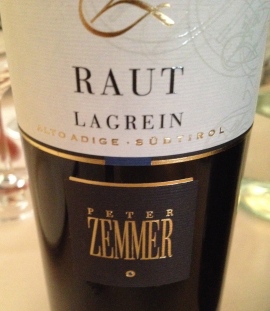Riccardo Gabriele of Pr-vino, an Italian PR company that represents European wineries, invited me to taste some of his line of Italian wines. I know Riccardo for a number of years and he represents some of the best wineries in Italy. The tasting and lunch was at Il Cardoncello NYC, a restaurant not far from where I live. The restaurant is named for the cardoncelli mushrooms that grow in Puglia. I ordered the cardoncelli and I really enjoyed them.. The earthy flavor of the mushrooms were a perfect compliment for the wine.
Cardoncelli Mushrooms
“Pratum” DOC Alto Adige Terlano Pinot Bianco 2015 Castel Sallegg made from 100% Pinot Bianco from the “Pratum” selection of grapes from the Prey vineyards’ oldest vines at 550 meters. The soil is porphyry and gardeno sandstone and the training system is guyot. After pressing the wine undergoes low-temperature must clarification and subsequent controlled cool fermentation at 15-18C. 2/3 of the wine is aged in stainless steel and 1/3 in French tonneaux casks (500 liters). This was a full-bodied white wine with hints of peach, tropical fruit, and a touch of vanilla. It has a nice mineral quality, well-balanced acidity and a long lingering finish and pleasant aftertaste.
Chianti Classico 2015 DOCG Quercia Al Poggio Made from 80% Sangiovese and 20% Ciliegiolo, Canaiolo and Colorino, all indigenous Tuscan grapes which are certified organic. The soil is limestone, clay, schist and calcareous clay galestro. The vines are Cordon trained and spur-pruned guyot. Harvest is manual. Traditional red winemaking in temperature controlled stainless steel and cement. The wine is aged in 500 liter old French oak barrels for 24 months and 6 months in bottle before release.The winery is located in Barberino Val d’Elsa which is between Florence and Siena. They use organic farming methods. This is a very drinkable Chianti with hints of blackberry and violets.
Montefalco Rosso DOC 2016 Di Filippo made from 60% Sangiovese, 20% Barbera and 10% Sagrantino. The grapes are grown on hillside vineyards and the soil is clayey-calcareous. The training system is spur cordon, there are 5,00 plants per hectare. Traditional red wine vinification in stainless steel tanks and maturation is in stainless steel tanks. This is a medium bodied easy drinking wine with good fruit and hints of red berries, with cherry notes and a touch of spice. It is an excellent food wine. The Di Filippo winery is 30-hectares and overlooks Assisi on the hills between Torgiano and Montefalco in the heart of Umbria.
Barolo “Ravera” 2013 DOCG Giovanni Abrigo made from 100% Nebbiolo. The winery is located in Diano d’Alba, province of Cuneo in southern Piedmont. It is family owned and run. The vineyards are at 400 to 500 meters and the grapes are picked by hand. The training system is guyot and the average age of the vines is 30 years. The Ravera vineyard is two hectares and is one of the major crus in the Novello area. The soil is composed of Saint’Agata marls with thick calcareous strata which alternate with strips of sand. Aging takes place in Slavonian casks. Riccardo said the distinctive character of wines from the Ravera vineyard are balsamic aromas of mint and eucalyptus.
Brunello di Montalcino “Madonna della Grazie” 2013 DOCG 100% Sangiovese. Il Marroneto This wine is made from a selection of grapes from the historical vineyard. The name of the wine comes from the little 12th century Madonna della Grazie church very near the vineyard. Fermentation is in Allier oak vats where it remains untouched for 2 days and the fermentation lasts for 20/22 days. The wine is aged in 2,500 liter oak barrels for 41 months and 10 months in bottle before release. It a complex and elegant wine with aromas and flavors of citrus, cherry, licorice, mineral notes, and that certain something wonderful on the palate that just keeps on lingering. It has an extremely pleasing aftertaste and a long finish. This is an excellent food wines and will age for a long time. It may be the best Brunello!
Amarone Della Valpolicella Classico 2013 DOC Tommasi made from 50% Corvina Veronese, 15% Corvinone, 30% Rondinella and 5% Oselta from grapes grown on hillside vineyards in Conca d’Oro. The traditional pergola veronese and the modern guyot methods of training the vines are used and only the best and most mature clusters are selected by hand for the Amarone. The grapes are dried for 4 months before they are pressed, and then the wine is aged for 30 months in Slavonian oak casks of 35 HL It remains in the bottle for at least another year before release. This is a full bodied complex wine with hints, of cherry, plum and blackberry. It is an Amarone that is food friendly and will age.
































